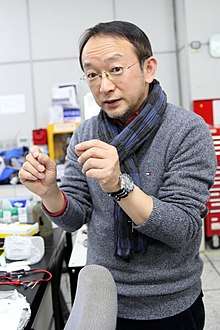Yeom Han-woong
Yeon Han-woong (born 5 December 1966) is a South Korean physicist. A tenured professor at POSTECH, he has led several research centers for the university and from 2013 in collaboration with the Institute for Basic Science. He is a Fellow of the American Physical Society and has served as vice chairman of the Korean government's first science and technology advisory group.[1] With more than 300 publications to his name, his research has been cited over 5,000 times giving him an h-index of 40 and i10-index of 125.[2]
Yeom Han-Woong | |
|---|---|
 Yeom Han-Woong | |
| Born | 5 December 1966 |
| Nationality | South Korea |
| Alma mater | Tohoku University |
| Known for | Pioneering the physics research of self-assembled atomic wires |
| Awards | Young Researcher of the Year, Japanese Society for Synchrotron Radiation Research (1999) Scientist and Engineer of the Month, Ministry of Science and Technology of Korea (2006) |
| Scientific career | |
| Fields | Physics |
| Institutions | Pohang Institute of Science and Technology, Yonsei University, Institute for Basic Science |
| Doctoral advisor | Shozo Kono |
| Yeom Han-woong | |
| Hangul | |
|---|---|
| Hanja | |
| Revised Romanization | Yeom Hanung |
| McCune–Reischauer | Yŏm Hanung |
Career
He was born in Seoul, and studied physics as an undergraduate at Seoul National University before going on to Tohoku University in Japan as a doctoral student. Thereafter he was a research associate at the Department of Chemistry, University of Tokyo (1996–2000). He then returned to his native South Korea, where he was an assistant/associate professor at the Department of Physics, Yonsei University (2000–2009), and then a full professor (2009–2010). During his time at Yonsei, he was part of a research team that developed a semiconductor nanometer wire with a thickness of 1 to 3 atoms.[3][4]
Afterwards he moved to the Department of Physics, POSTECH (2010–present), where he served as director of Center for Atomic Wires and Layers (2003–2012), director of Center for Low Dimensional Electronic Symmetries (2012–2013), and founding director of Center for Artificial Low Dimensional Electronic Systems, Institute for Basic Science (2013–present).[5][6]
Awards
- 1999: Young Researcher of the Year, Japanese Society for Synchrotron Radiation Research[7]
- 2006: Outstanding Faculty of the Year, Yonsei University[7]
- 2006: Scientist and Engineer of the Month, Ministry of Science and Technology[8]
- 2007: Academic Achievement Award, Korean Physical Society
- 2007: Honored Invitation as Young Scientist of Asia, Japanese Society of Applied Physics
- 2010: Outstanding Referee (Lifetime honor), American Physical Society[9]
- 2012: Leading Korean Research Scientist, Korean Academy of Science and Technology
- 2015: Korea Science Award, President of Korea[10]
- 2016: Inchon Award for Science and Technology, Inchon Foundation and Dong-A Daily Newspaper
- 2017: Kyung-Ahm Prize in Natural Science, Kyung-Ahm Prize Foundation[11][12]
Selected publications
- Self-Assembled Nanowires with Giant Rashba Split Bands. Phys. Rev. Lett. 110, 036801 (2013).
- Topological Solitons versus Nonsolitonic Phase Defects in a Quasi-One-Dimensional Charge-Density Wave. Phys. Rev. Lett. 109, 246802 (2012).
- Radial band structure of electrons in liquid metals. Phys. Rev. Lett. 107, 136402 (2011).
- Nearly Massless Electrons in the Silicon Interface with a Metal Film. Phys. Rev. Lett. 104, 246803 (2010).
- Giant kink in the electron dispersion of strongly coupled lead nanowires. Nano Lett. 9, 1916 (2009).
- Choi, Won Hoon; Kang, Pil Gyu; Ryang, Kyung Deuk; Yeom, Han Woong. "Band-structure engineering of gold atomic wires on silicon by controlled doping". Physical Review Letters. American Physical Society. 100 (12): 126801. doi:10.1103/PhysRevLett.100.126801. Retrieved 28 January 2019.
References
- 신, 선미 (12 December 2018). "염한웅 포항공대 교수 "혁신성장의 가장 큰 축은 '과학'"". Yonhapnews (in Korean). Retrieved 28 January 2019.
문재인 정부의 첫 과학기술자문회의 부의장을 맡았던 염한웅 포항공대 물리학과 교수는 13일 서울 강남구 한국과학기술회관에서 열린 '혁신성장을 위한 국가혁신체계 2019 대토론회'에서 현 정책의 문제점을 이같이 지적했다.
- "Han Woong Yeom - Google Scholar Citations". Google Scholar. Retrieved 28 January 2019.
- Choi, Won Hoon; Kang, Pil Gyu; Ryang, Kyung Deuk; Yeom, Han Woong. "Band-structure engineering of gold atomic wires on silicon by controlled doping". Physical Review Letters. American Physical Society. 100 (12): 126801. doi:10.1103/PhysRevLett.100.126801. Retrieved 28 January 2019.
- Kang, Pil-Gyu; Jeong, Hojin; Yeom, Han Woong (11 April 2008). "Hopping Domain Wall Induced by Paired Adatoms on an Atomic Wire: Si (111)−(5×2)−Au". Physical Review Letters. American Physical Society. 100 (14): 146103. doi:10.1103/PhysRevLett.100.146103. Retrieved 28 January 2019.
- "Center for Artificial Low Dimensional Electronic Systems - Physics - Research Centers". Institute for Basic Science. Retrieved 28 January 2019.
- herve_lemoine (1966-12-05). "Prof. Han Woong Yeom" (PDF). Webcache.googleusercontent.com. Archived from the original on 2016-05-05. Retrieved 2013-11-29.CS1 maint: BOT: original-url status unknown (link)
- ICAMD2015_CV_Han Woong Yeom (PDF). 9th International Conference on Advanced Materials and Devices. Jeju Hotel, South Korea. 7–9 December 2015. Retrieved 28 January 2019.
- 이, 철균 (2 August 2006). "'이달의 과학기술자상' 염한웅 연세대교수". Naver (in Korean). 서울경제. Retrieved 28 January 2019.
- Lee, Sang-min (14 April 2010). "Prof. Han Woong Yeom Selected as Outstanding Referee of APS". The Postech Times. POSTECH. Retrieved 28 January 2019.
- "Yeom Han Woong Wins 2015 Korea Science Award: Professor Yeom Han Woong has won the 2015 Korea Science Award, becoming the 6th IBS director to do so". Asian Scientist. 5 January 2016. Retrieved 10 January 2019.
- 이, 종민 (18 September 2017). "올해 제13회 경암상에 김경동·승효상 등 5명 선정". Yonhapnews (in Korean). Retrieved 28 January 2019.
- 전, 상후 (19 September 2017). "올해 제13회 경암상에 김경동 서울대 명예교수, 승효상 동아대 석좌교수 등 5명 선정". Segye (in Korean). Retrieved 28 January 2019.